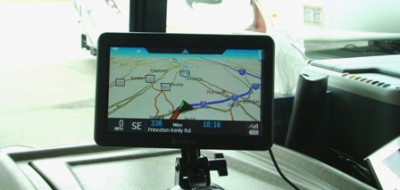 Negotiating turns in an RV can be tricky. These RV driving tips are crucial to safe travel on the road. Whether you are driving a large motor home or pulling a large trailer, safely negotiating sharp turns is a necessary skill. Due to the excessive length of these vehicles, right turns in tight quarters can be quite challenging and sometimes impossible. For these events, it is important that the operator use good judgment in assessing if such a turn can be done safely or not. Three left turns under most circumstances will deliver the same results as one right turn, and in many cases, can be far safer.
Negotiating turns in an RV can be tricky. These RV driving tips are crucial to safe travel on the road. Whether you are driving a large motor home or pulling a large trailer, safely negotiating sharp turns is a necessary skill. Due to the excessive length of these vehicles, right turns in tight quarters can be quite challenging and sometimes impossible. For these events, it is important that the operator use good judgment in assessing if such a turn can be done safely or not. Three left turns under most circumstances will deliver the same results as one right turn, and in many cases, can be far safer.
 To fully understand this, we must look at the procedure required to make a 90-degree turn in a long vehicle. The safest manner to accomplish this requires the driver to delay turning the vehicle until he, or she, is looking straight down the lane they will be in after the turn. At that time, a full turn should bring the unit squarely down the targeted lane while the rear will follow without issue. With that technique in mind, caution should be observed when using multiple turn lanes – intersections that have two or more turning lanes either right or left. For these you must be in the outer-most lane position. This is either the right-side lane of a left turn bank, or the left-side lane of a right turn bank. Doing this will eliminate traffic on the outside of your turn allowing you to extend the turn without the danger of hitting any other vehicles.
To fully understand this, we must look at the procedure required to make a 90-degree turn in a long vehicle. The safest manner to accomplish this requires the driver to delay turning the vehicle until he, or she, is looking straight down the lane they will be in after the turn. At that time, a full turn should bring the unit squarely down the targeted lane while the rear will follow without issue. With that technique in mind, caution should be observed when using multiple turn lanes – intersections that have two or more turning lanes either right or left. For these you must be in the outer-most lane position. This is either the right-side lane of a left turn bank, or the left-side lane of a right turn bank. Doing this will eliminate traffic on the outside of your turn allowing you to extend the turn without the danger of hitting any other vehicles.
Correct turn signal operation is another RV driving tip that comes to mind when discussing lanes. Unlike an automobile that may display a simple flash of their directional signals to move over a lane, an RV does not. First of all, the physical lane change in a large vehicle takes more time. It is done more gradually than that of an auto. Furthermore, blind spots increase due to the length of the vehicle. To accomplish lane changing safely, an RV driver must make their intentions evident to the surrounding traffic early on. This requires the operation of the directional signal to begin just prior to starting a lane change, and maintain it until the RV is completely in the new lane. This extended operation also serves as an additional safety feature if the RV is equipped with mid-body flashers. A motor bike in a blind spot may then also understand your intentions and take appropriate actions.
Finally, we should touch on the importance of lane line colors. Yellow lines separate traffic in the opposing direction, while a white painted line divides vehicles going the same way. Ever wonder during a long drive if you are on a single lane highway or a dual carriageway? Just check the color of the road marker paint. Drive safely and enjoy.
